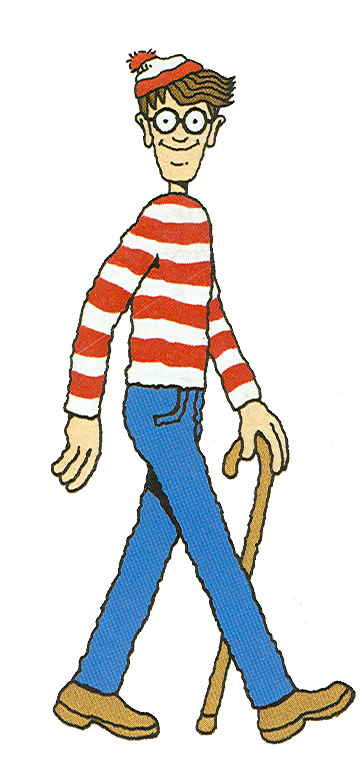 We've written before about cartoon controversies at the Washington Post. There was this anti-Pentecostal cartoon from 2008. And then there was his anti-Israeli cartoon depicting a fanged Star of David being pushed by a headless, goosestepping soldier. Subtle.
But while the Washington Post has run those cartoons, they're in a spot of trouble for a cartoon they didn't run this week. Playing off of the "Where's Waldo" books, "Non Sequitur" cartoonist Wiley Miller depicted a vibrant park scene with people and animals frolicking about. The text above the picture reads "Picture book title voted least likely to ever find a publisher . . . " And below the picture, the answer: "Where's Muhammad?"
We've written before about cartoon controversies at the Washington Post. There was this anti-Pentecostal cartoon from 2008. And then there was his anti-Israeli cartoon depicting a fanged Star of David being pushed by a headless, goosestepping soldier. Subtle.
But while the Washington Post has run those cartoons, they're in a spot of trouble for a cartoon they didn't run this week. Playing off of the "Where's Waldo" books, "Non Sequitur" cartoonist Wiley Miller depicted a vibrant park scene with people and animals frolicking about. The text above the picture reads "Picture book title voted least likely to ever find a publisher . . . " And below the picture, the answer: "Where's Muhammad?"
Considering the sensitivities surrounding the depiction of Muhammad, the cartoon was well executed for maximum provocation with minimum outrage.
But that doesn't mean that the Washington Post printed it. And they weren't alone -- neither did the Los Angeles Times nor the San Francisco Chronicle. Post ombudsman Andrew Alexander was displeased. He devoted his Sunday column to the subject:
What is clever about last Sunday's "Where's Muhammad?" comic is that the prophet does not appear in it.
Still, Style editor Ned Martel said he decided to yank it, after conferring with others, including Executive Editor Marcus W. Brauchli, because "it seemed a deliberate provocation without a clear message." He added that "the point of the joke was not immediately clear" and that readers might think that Muhammad was somewhere in the drawing.
Some readers accused The Post of censorship. "Cowards," e-mailed John D. Stackpole of Fort Washington, one of several who used that word.
Miller is fuming. The award-winning cartoonist, who lives in Maine, told me the cartoon was meant to satirize "the insanity of an entire group of people rioting and putting out a hit list over cartoons," as well as "media cowering in fear of printing any cartoon that contains the word 'Muhammad.'"
"The wonderful irony [is that] great newspapers like The Washington Post, that took on Nixon . . . run in fear of this very tame cartoon, thus validating the accuracy of the satire," he said by e-mail.
The column itself is well written. Alexander explains that the cartoon accidentally ran on the The Post website and that the paper ran a similar cartoon by Miller during the 2006 Danish cartoon riots that left over 100 people dead. That earlier cartoon showed a street artist next to a sign that said, "Caricatures of Muhammad While You Wait!" He ends his column by saying that the paper's decision "can be seen as timid. And it sets an awfully low threshold for decisions on whether to withhold words or images that might offend."
Timid is a pretty timid word to use for this censoring. It's the same word Los Angeles Times media columnist James Rainey used when he complained ever so mildly about his paper's refusal to publish the cartoon. In fact, he went out of his way to say he disagreed with those who have called the refusal to run the comic "a cowardly retreat from radicals." He says that what others see as cowardice, he sees as expediency. He quotes from the Washington Post ombudsman piece and adds the perspective of a few other papers:
The Boston Globe had a similar complaint. Deputy managing editor Christine Chinlund said via e-mail: "When a cartoon takes on a sensitive subject, especially religion, it has an obligation to be clear. The 'Where's Muhammad' cartoon did not meet that test. It leaves the reader searching for clues, staring at a busy drawing, trying to discern a likeness, wondering if the outhouse at the top of the drawing is significant -- in other words, perplexed."
Said Alice Short, an L.A. Times assistant managing editor: "If they had produced a 'Non Sequitur' cartoon that said 'Where's Jesus?' I probably wouldn't have wanted to run that either."
But if the newspaper editors went about the business of killing less than A-plus work, the comic pages would have many blank spots every day. The result would be the same if they always leaned over backward to cater to the most sensitive among us.
I wonder, does anyone in the world believe Alice Short's comment? When I read that quote, I put my fist up to my mouth and then coughed out "bullhockey." Matt Welch over at Reason says the same in his post ""Just Admit it, Newspapers: You're Scared of Muslims"."
Thought-provoking is good. Needless provocation is not. This cartoon -- which you can see here -- is in the former category.
So what do you think? Is the free press doomed if we can't run inoffensive cartoons that don't depict Muhammad?
